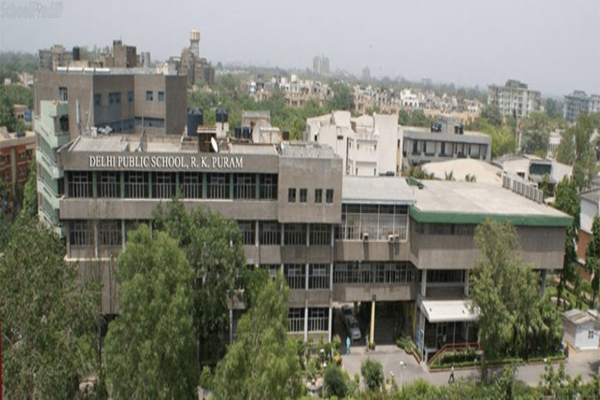product
EZ Vidya launches Chrysalis software for schools
 Chennai (India) based Company, EZ Vidya has launched 'Chrysalis' a comprehensive computer science curriculum for classes I through X with an objective to replace the conventional textbooks and classroom learning.
Chennai (India) based Company, EZ Vidya has launched 'Chrysalis' a comprehensive computer science curriculum for classes I through X with an objective to replace the conventional textbooks and classroom learning.
The curriculum is aimed to make students 'IT-capable than just IT- literate'. A typical classroom module from Chrysalis will encourage students to create multimedia packages on general topics. EZ Vidya has partnered Wipro in “teacher empowerment programmes” across the country. The company has also brought out a multimedia CD title 'Thiruvalluva Ula” for the Azim Premji Foundation. The students will use sound and animation files in the module to create presentations.
IBM to break language barrier through MASTOR
IBM has been experimenting with the translation and speech technology through its prototype software, dubbed Multilingual Automatic Speech-to-Speech Technology or MASTOR.
Through MASTOR, translation can be done in real time. IBM wants to explore market opportunities where demand for language translation technologies are is high, including medical facilities, law enforcement, banking and travel. IBM is also planning to bring this technology to use in e-mails.
partnership
i-flex builds DSS for education department of Indian State
i-flex solutions, banking software maker has signed a Memorandum of Understanding (MoU) with the Indian State Government of Karnataka to build a Decision Support System (DSS) for the state's education department.
i-flex's Center for Business Intelligence (CBI) is developing the DSS in two phases. The company has developed the DSS, which is helping the Karnataka State Quality Assessment Organisation (KSQAO), a part of the Department of Education in analysing the quality of education of around 19 lac children in 41,000 schools of the State. The Chief Minister of Karnataka, H. D. Kumaraswamy, has launched the 'Karnataka Schools towards Quality Education' programme on the basis of i-flex's DSS. i-flex is also planning to work with the Policy Planning Unit and e-Governance unit of the Education Department. DSS system shares the information on the assessment with all stakeholders, parents, teachers, communities and political representatives, to enable collective efforts to work towards quality education in the State.
Motorola signs MoU with IIIT-B in India on wireless solutions
Motorola Inc. has signed a comprehensive Memorandum of Understanding (MoU) with the International Institute of Information Technology Bangalore (IIIT-B) to research solutions in India.
This joint venture will develop cutting-edge technology innovations and solutions, conduct research programmes and work on projects in designated fields of science and technology. This partnership will also enable Motorola to effectively utilise the results of the research efforts aimed at developing innovative wireless broadband solutions for emerging markets like India.
NIIT ties with IBM for research programmes in India
The National Institute of Technology-Karnataka in India has signed two MoUs with IBM for research and academic collaboration.
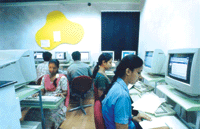 Under the first MoU, NITK, IBM's Centre for Advanced Studies (CAS) will develop technologies and capabilities of common interest and engage in collaborative research. IBM will support NITK students and faculty to do their research in the areas of automatic computing, grid computing, deep computing, life sciences, databases and web services. Under the second MoU, corporate and institution will work together to create an 'IBM Open Power Systems Laboratory' for students and faculty of NITK.
Under the first MoU, NITK, IBM's Centre for Advanced Studies (CAS) will develop technologies and capabilities of common interest and engage in collaborative research. IBM will support NITK students and faculty to do their research in the areas of automatic computing, grid computing, deep computing, life sciences, databases and web services. Under the second MoU, corporate and institution will work together to create an 'IBM Open Power Systems Laboratory' for students and faculty of NITK.
STMicroelectronics ties with Indian institutes to set up research labs
STMicroelectronics has tied up with BITS Pilani and IIT Delhi to set up research and innovation lab in BITS-Pilani and IIT Delhi in India.
The main objective of the partnership is to provide VLSI designing and embedded systems knowledge among students by undertaking research projects with involvement of faculty, students and ST representatives. The research area would be focused on analog and mixed-signal design in the area of VLSI, image speech pattern recognition, sensory organ modeling and digital data protection in algorithm research, along with generic IP blocks for embedded solutions. ST's lab would be equipped with necessary hardware, software tools and reference boards and technology parameters for successful execution of projects identified areas.
QUT partners with Microsoft to set up e-research centre
Queensland University of Technology (QUT) in Australia has partnered with Microsoft to open e-research centre. A US$2.13 million international e-research center will help scientist to measure climate change and assess the health of ecosystems.
The new Microsoft QUT e-research centre, will enable scientists to spend more time discovery and invention by automating the data processes that are necessary to their research. Microsoft Corp., QUT and the Queensland Government jointly fund the virtual lab.
project
Intel launches second phase 'Intel Teach Programme' in Morocco
Intel Corporation has signed a Memorandum of Understanding (MoU) with Ministry of Education of Morocco to develop the second phase 'Intel Teach Programme'.
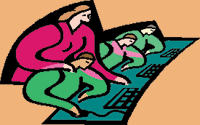 This professional development-training programme will provide appropriate information and communication technology, teacher training, relevant content and connectivity in the North African curriculum. MoE Morocco and Intel will train 3000 of the education pre-services teachers by using the localised Moroccan version of the Intel Teach training manuals. As a part of Intel's World Ahead Program, the company is investing more than US$1 billion worldwide in a broad new programme. The main aim of Intel Teach Programme is to help students develop the thinking skills they will need in order to participate and succeed in a knowledge-based economy. The programme also incorporates use of the Internet, Web page design, and student projects as vehicles to powerful learning.
This professional development-training programme will provide appropriate information and communication technology, teacher training, relevant content and connectivity in the North African curriculum. MoE Morocco and Intel will train 3000 of the education pre-services teachers by using the localised Moroccan version of the Intel Teach training manuals. As a part of Intel's World Ahead Program, the company is investing more than US$1 billion worldwide in a broad new programme. The main aim of Intel Teach Programme is to help students develop the thinking skills they will need in order to participate and succeed in a knowledge-based economy. The programme also incorporates use of the Internet, Web page design, and student projects as vehicles to powerful learning.
Excelsoft sets e-learning subsidiary in Hyderabad in India
Excelsoft Technologies, Mysore based e-learning solutions provider announced that the company would set up its subsidiary in Hyderabad, India.
The new subsidiary called Huper LDT will focus on corporate e-learning solutions and develop instructionally designed content. Huper LDT will create Simulations and mobile platform based content for cross-section of corporate employees including senior management, project managers, new entrants and sales force and marketing professionals. Huper LDT will also provide the back-end development for creating animations and provide e-learning content to the Middle East countries. Huper LDT has signed a deal with US based company, Xora to provide consulting services in the area of performance oriented curriculum design. Xora is a solution provider for tracking workforce through the mobile phones.

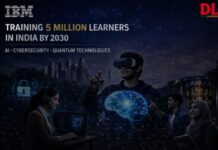

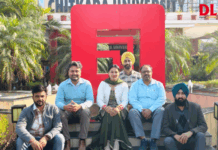



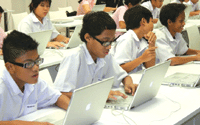 We led by example. Leadership is an essential component of change management and we are fortunate at Henderson to have a supportive Principal and Vice Principal who gave us their wholehearted support. With their help, we went ahead with the podcast project. Our colleagues, along the way, realised how great an impact our lessons were having on the students and it was not long before more teachers were enquiring about podcasting and if they could learn how to create their own podcasts.
We led by example. Leadership is an essential component of change management and we are fortunate at Henderson to have a supportive Principal and Vice Principal who gave us their wholehearted support. With their help, we went ahead with the podcast project. Our colleagues, along the way, realised how great an impact our lessons were having on the students and it was not long before more teachers were enquiring about podcasting and if they could learn how to create their own podcasts.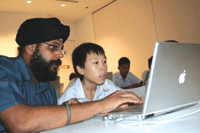 At the heart of our podcast project was a deep desire to get our students to participate in our Social Studies lessons. We realised that the levels of motivation were dropping, students were not bringing their books and some were even dozing off during our lessons. We wanted to create lessons that would excite and engage our students. At the same time, we were acutely aware of the call to re-look, review and revisit our pedagogy and teaching practice coming from our Prime Minister and Education Minister in the form of two initiatives, Teaching School, Learning Nation and Teach Less, Learn More. Podcasting was one approach to addressing our challenges.
At the heart of our podcast project was a deep desire to get our students to participate in our Social Studies lessons. We realised that the levels of motivation were dropping, students were not bringing their books and some were even dozing off during our lessons. We wanted to create lessons that would excite and engage our students. At the same time, we were acutely aware of the call to re-look, review and revisit our pedagogy and teaching practice coming from our Prime Minister and Education Minister in the form of two initiatives, Teaching School, Learning Nation and Teach Less, Learn More. Podcasting was one approach to addressing our challenges.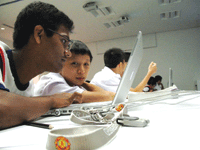 Students Perspective
Students Perspective









